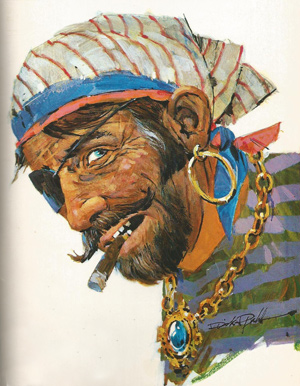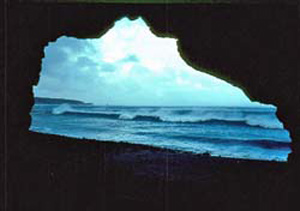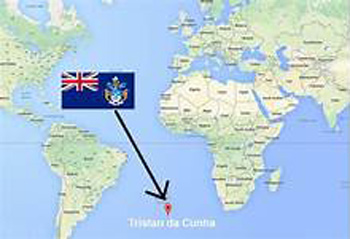Part III – Pirates and Buried Treasure on Tristan Archipelago

Pirates felt safe on the remote islands of Tristan Archipelago Credit: Jack Beater
In 1506, when Portugal navigator Tristan da Cunha discovered a remote island in the South Atlantic Ocean, he gave his name to it and planned to return and go ashore at a later date. He kept a log where he recounted a desire to explore “his” isle and three others: Nightingale, Gough and Inaccessible (named for difficulty in going ashore) islands that later became Tristan Archipelago. But the venturesome navigator never returned. If truth be told, Tristan probably planned to return and search for pirate treasure buried on these four far-flung uninhabited islands. Even then—in the 1600s—pirates were a common threat as they roamed the seas off the coasts of all the continents.
Attacks by marauders bearing acts of violence on the high seas were common in bygone days. But it was the Golden Age of Piracy, 1700 to 1725, that captured headlines and made protagonists from the likes of Calico Jack Rackham, Edward Teach (Blackbeard), Henry Morgan and others who preyed on merchant ships laden with the riches from India, Africa, South America and the Caribbean. There were few treasure ships to loot, most them protected by military escorts. When raiding towns or seizing merchant ships, pirates sold what they carried off: small arms, gunpowder, silverware, tobacco, spices, sugar, china and anything else they could peddle on the black market. Some of the buccaneers–Capt. Kidd for one–buried their treasure on deserted islands while others squandered their share of the booty on booze and women. It was a tough line of work that often led to injury or death. The average career of a pirate lasted three years. Will Rogers called it the “shortest lived profession on earth.”

Looking out from cave on Tristan da Cunha where silver coins were found Credit: Tristan Tourism
Many islands are embellished as “treasure isles,” including those of the Tristan Archipelago. Early records reveal their authenticity and the presence of pirates who sought remote refuges to bury their caches. English, Dutch and French mercenaries, posing as privateers (backed by the government), plundered and pillaged, then fled with their stash–some to be split and perhaps some to be hidden.

Silver coins found in Archway Caves on Inaccessible Island Top: Original state of coins, Bottom: Some of them cleaned Credit: Ellsworth Boyd
The best tale comes from the island of Tristan da Cunha as told by author Thomas Terry in his book, “Doubloons and Other Buried Treasures.” It begins with Jonathan Lambert, the founder of the island in 1810. He and two cohorts, all suspected of being former pirates, were joined by shipwrecked sailors, derelicts, deserters and castoffs from St. Helena Island in a sealing operation (seals killed for their pelts, oil and meat) that grossed little profit. When Lambert died two years later in a boating accident, his friend Tomason Corrie remained on the island until 1816. That’s when British troops were occupying it, fearing the French might try to rescue Napoleon who was exiled to St. Helena over 1,000 miles away. Corrie, who suffered from depression while living in a hut near Edinburgh-by-the-Sea, the only inhabited settlement on the islands, packed up his belongings and moved seven miles away to Sandy Point. Like a hermit, he found shelter and solace there in a maze of subterranean caves hewn by Mother Nature into cliffs overlooking a small beach inhabited by Northern rockhopper penguins.

Northern rockhopper penguins inhabit the beach on Tristan da Cunha Credit: Tristan Tourism

The Tristan Archipelago, a British Overseas Territory, is located in the South Atlantic Ocean between Africa and South America Credit: Tristan da Cunha Tourism
Chances are the treasure found throughout the years on Tristan Archipelago came from pirate ships sailing out of Madagascar. Located 250 miles off the southeast coast of Africa, the island was a pirate stronghold for years. Ships skirted the Cape of Good Hope, heading north toward the island of St. Helena, which was a layover for merchantmen sailing to Europe from Asia and South Africa. Midway through the voyage, pirates often stopped at one of the isolated islands of Tristan Archipelago. Anchoring offshore, the crew launched their longboats to row into the small beaches surrounded by rocky coasts. After setting up a makeshift beach encampment, they stockpiled fresh water, penguin eggs and seal meat, then proceeded to gamble and guzzle “rumbullion.” A concoction of dark rum laced with spices, it was so hot and hellish, sailors called it “kill devil kickback.” The drinking, gambling and beach bashes left a plethora of empty bottles and silver coins lost by the tipsy ruffians. Many of the coins were found over the years on beaches off Nightingale and Gough Islands.
Although storms invariably strike Tristan, its residents–exposed to the elements from birth—progress like they have for two centuries. Each morning, the incessant cries of gulls and cormorants, as they descend from a halo of clouds, creates a sort of heavenly scene. Away from the maddening crowd, in the cradle of nature, hearty, hard-working souls of the settlement sport a pioneer spirit. Their true riches aren’t buried. They’re omnipresent in the simple, productive lives on their beloved “treasure island.”
Author: Ellsworth Boyd
Ellsworth Boyd, Professor Emeritus, College of Education, Towson University, Towson, Maryland, pursues an avocation of diving and writing. He has published articles and photo’s in every major dive magazine in the US., Canada, and half a dozen foreign countries. An authority on shipwrecks, Ellsworth has received thousands of letters and e-mails from divers throughout the world who responded to his Wreck Facts column in Sport Diver Magazine. When he’s not writing, or diving, Ellsworth appears as a featured speaker at maritime symposiums in Los Angeles, Houston, Chicago, Ft. Lauderdale, New York and Philadelphia. “Romance & Mystery: Sunken Treasures of the Lost Galleons,” is one of his most popular talks. A pioneer in the sport, Ellsworth was inducted into the International Legends of Diving in 2013.
8 Comments
Submit a Comment
All Rights Reserved © | National Underwater and Marine Agency
All Rights Reserved © | National Underwater and Marine Agency
Web Design by Floyd Dog Design
Web Design by Floyd Dog Design

Pete: Ha! Isn’t that true! I would go in a minute if I didn’t have this damn lower back problem. I’m going to a chiropractor in hopes he can give me some sort of relief. Getting to Tristan da Cunha would be a challenge and lots of fun. Right now, however, they have closed the island due to the virus. The Settlement and the way of life reminds me of the Amish. They are hard workers and sacrifice a lot for their family. Thank you for your comment. Continue to go to Numa.net. Cheers, E.B.
Pete’s comment (response above): Lets go E.B. If we croak enroute, or there, who cares? Beats sitting around wondering what it would be like if we just said, “to hell with it,” and went anyway! You know me, I’ll do it if you will.
Thanks again Mr Boyd for and enjoyable read about this unusual haven. You have a special gift for creating imagery with the written word. Keep the articles flowing!
Thanksfor your kind comments. Tristan da Cunha truly is an “unusual haven.” It sort of reminds me of the Amish who have settled not far from where I live. They remain self-contained, hard working people whose religious beliefs stress family, responsibility, ethical behavior and education.
Thanks for the articles! I came across Tristan while looking around the world on google maps a few years ago. I have always wanted to go!
Trevor: I’m glad you liked the articles. Some friends of mine read the series on Tristan da Cunha too, and one them said the same thing. He wants to go there and has it on his bucket list.
I just learned that NUMA was a real organization! This is awesome!!
Yes! If you read some of Clive Cussler’s books, you will find the Numa team at work under the guidance of hero Dirk Pitt. Clive, along with his real life Numa team, discovered dozens of shipwrecks. You can read about them in Clive’s two books: Sea Hunters I & II. Clive is gone now, but his discoveries will remain in the history books forever.